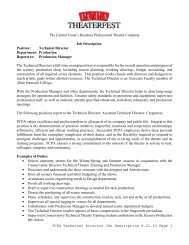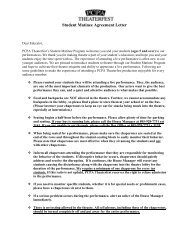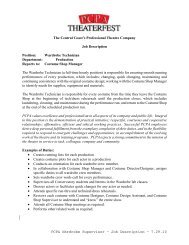A Christmas Carol - PCPA Theaterfest
A Christmas Carol - PCPA Theaterfest
A Christmas Carol - PCPA Theaterfest
You also want an ePaper? Increase the reach of your titles
YUMPU automatically turns print PDFs into web optimized ePapers that Google loves.
more common and also advanced trade. The importation of goods such as corn from the United States and meat<br />
from Australia was a part of such trade. Another engineering development in the Victorian Era was the sewage<br />
system from London. It was designed by Joseph Bazalgette in 1858. He proposed to build 82 mi (132 km) of<br />
sewer system linked with over 1,000 mi (1,600 km) of street sewers. Many problems were encountered but the<br />
sewers were completed.<br />
Another important innovation in communications was the arrival of Penny Black, the first postage stamp, which<br />
standardized postage rates to a flat price regardless of distance. Photography was realized in 1839 by Louis<br />
Daguerre in France and William Fox Talbot in the UK.<br />
Poverty: 19th century Britain saw a huge population increase accompanied by rapid urbanization stimulated by<br />
the Industrial Revolution. The large numbers of skilled and unskilled people looking for work kept wages down<br />
to a bare subsistence level. Available housing was scarce and expensive, resulting in overcrowding. These<br />
problems were magnified in London, where the population grew at record rates. Large houses were turned into<br />
flats and tenements, and as landlords failed to maintain these dwellings slums developed. Kellow Chesney<br />
described the situation as follows: "Hideous slums, some of them acres wide, some no more than crannies of<br />
obscure misery, make up a substantial part of the metropolis... In big, once handsome houses, thirty or more<br />
people of all ages may inhabit a single room."<br />
Child labour: The Victorian era became notorious for the employment of young children in factories and mines<br />
and as chimney sweeps. Child labour, often brought about by economic hardship, played an important role in<br />
the Industrial Revolution. Agile boys were employed by the chimney sweeps; small children were employed to<br />
scramble under machinery to retrieve cotton bobbins; and children were also employed to work in coal mines,<br />
crawling through tunnels too narrow and low for adults.<br />
Children also worked as errand boys, crossing sweepers, or shoe blacks, or selling matches, flowers, and other<br />
cheap goods. Some children undertook work as apprentices to respectable trades, such as building, or as<br />
domestic servants (there were over 120,000 domestic servants in London in the mid 18th century). Working<br />
hours were long: builders might work 64 hours a week in summer and 52 in winter, while domestic servants<br />
worked 80 hour weeks. Children as young as four were put to work. In coal mines children began work at the<br />
age of 5 and generally died before the age of 25. Many children (and adults) worked 16 hour days. As early as<br />
1802 and 1819, Factory Acts were passed to limit the working hours of workhouse children in factories and<br />
cotton mills to 12 hours per day. Many young people worked as prostitutes (the majority of prostitutes in<br />
London were between 15 and 22 years of age).<br />
23














